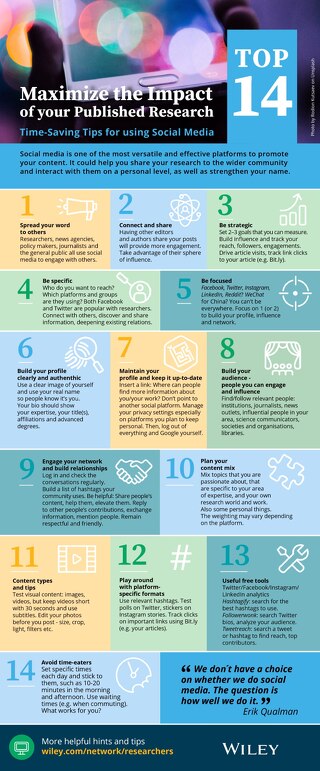how-to-create-awesome-images-for-promoting-your-work-via-social-media
July 23, 2015
Social media is probably one of the best ways to get your research noticed. Use images to ensure that your digital profiles are optimized when creating content for your blogs, websites, or social media channels. There are numerous online tools to help you find images, but it’s often hard to figure out if you can legally use the images you find.
Creating Visual Content with Canva
The image tool I’ve had the most success with is Canva (http://www.canva.com/). It’s an all-in-one innovative online drag-and-drop graphic design tool that’s amazingly easy to use to create professional looking images. It has more than one million pics, graphics, and fonts that you can use to create your own original images.
People love visual images. We love making them, looking at them, sharing them, and (oh yeah) commenting on them.
You are limited only by your imagination!
Getting Started
1. Sign up to use Canva’s free graphic design tool
2. Pick one of Canva’s stunning Templates to use
3. Customize the template, adding your own photo(s), or dragging and dropping the free graphics or text to create your original design
4. Save and download.
Canva has plenty of tutorials to start you off on your graphic design journey. There’s also a blog chock full of helpful tips and techniques on graphic design. It leans towards business marketing, but I don’t need to remind you that marketing your research is necessary and no longer an option.
Source: Lynda Tait
Start Designing
There are only a few steps to unleashing your creativity.
Step 1: Choose a Template. The first screen invites you to start a new design and presents several layouts for you to select for Posters or Presentations, and across popular social media platforms such as Pinterest, Facebook covers, Blog graphics, or a Twitter header, and documents, brochures, cards and business cards, invitations, infographics, and a photo collage. You don’t even have to think about optimizing the image size, as it’s already done for you.
The site is great for creating exquisite images for your research study logos, posters, presentations, blog content, photo collages, invitations, flyers, marketing materials, and for sharing across all your social media sites as well.
Step 2: Start with a Layout. Pick a layout from the sidebar on the left side. Search or browse through the options, or even upload one of your own.
Step 3: Picking text and color. From this sidebar you can change the background or text, and upload your own images. Click on elements within the graphic and bin elements that you don’t want, and replace with other graphics or text. You can change the text size, font style, or pick different colors.
If you add something you don’t like, or you make a mistake – don’t panic – just use the undo button at the top. It’s that easy. Have fun playing with all the features and using your creativity.
Step 4: Publish. When you’re happy with the image you have created, click on “Link and Publish” to download the finished image to your desktop or save to a folder.
You can now use your original graphic image, designed by you, on your blog, Facebook or Twitter, for example, without having to worry about who owns the copyright.
You can also post your graphic images to image-based social networks and platforms such as Pinterest, and Instagram. These platforms have higher rates of engagement than others such as Facebook or Twitter, so the images that you create and share can drive more traffic to your digital content. Creating your own images will therefore capitalize on the power of visual media to raise visibility for your content with a wider audience.
The increasing importance of “impact” in assessing research excellence means that researchers, now more than ever before, need to maximize the effectiveness of knowledge exchange. If you want to create impact, you need to engage more effectively with a wider audience. Often overlooked in a research communication strategy, social media is a great way of providing access to audiences beyond our immediate reach. It offers a great opportunity to engage effectively with all your stakeholders, and get them to take notice of your research and why it’s of significance to them. Images play a central role in this strategy and, as you can see, it’s not difficult to create images for your social media platforms. You’ll get more social shares and more exposure for your research – take every opportunity to get your work noticed!
Okay, now go and unleash your own creativity!














